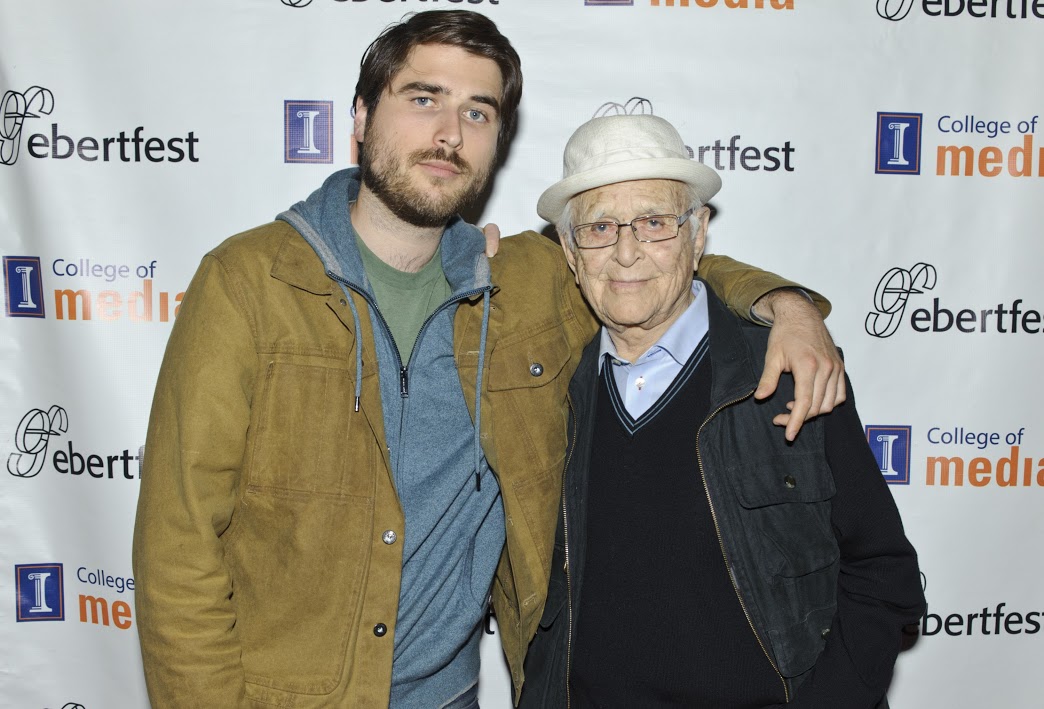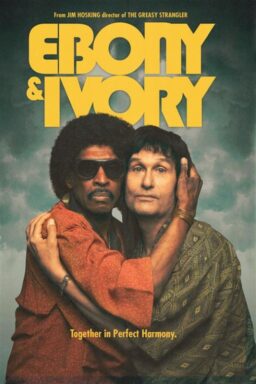How amazing to have documentaries from the two Lears at Ebertfest: One, about the iconic Norman Lear, and the other by his son Ben, who is forging his own path on the issues of social justice. “They Call Us Monsters” was produced by Sasha Alpert who appeared on stage for the Q&A, which was moderated by myself and Matt Fagerholm.
The following partial review of “Norman Lear: Just Another Version of You” was written by Matt Zoller Seitz and published in the catalogue of Ebertfest 2017. It screened at the festival on April 22nd with subject Norman Lear, co-director Rachel Grady and producer Brent Miller in attendance. Simon Kilmurry, head of IDA moderated the discussion.
Here is the introduction to the film, followed by the Q&A posted after the review. There are also links to other articles about these films and filmmakers immediately following the reviews.
“Norman Lear: Just Another Version of You” is a biography of one of TV’s most influential producers, and an influential American, period: the creator of “All in the Family,” “Maude,” “Good Times” and “The Jeffersons,” and the founder of the liberal activist group People for the American Way, which was founded as a response against evangelical activists to reclaim patriotism for the left. But while the film works as a primer for viewers who are curious about Lear but don’t know the details of his life and work, it’s more interesting as a movie about age and memory. Lear was 92 when the film was shot during a book tour last year, and while he’s as mentally and physically active as a person could hope to be at his age, the movie is suffused with melancholy, much of it stemming from Lear’s realization that most of his life is behind him.
Perhaps not coincidentally, it’s a film about faces. Most of Lear’s triumphs were in the 1970s: “All in the Family,” a politically charged sitcom based on the English series “Till Death Us Do Part,” debuted in CBS in 1971, when the Vietnam War, the antiwar movement, and the feminist, gay rights and civil rights movements were still powerfully active. The movie is filled with shots of Lear on the sets of these shows, leading script readings and consulting with actors, looking fit and alert and slim, and always clad in his trademark fedora.

The documentary’s co-directors, Heidi Ewing and Rachel Grady, shoot Lear in the present day with the sort of tender regard you might lavish on a grandparent if you had feature film-quality cameras and lighting and your grandparent didn’t mind being followed around by a movie crew. Their camera moves in close on Lear as he talks about his successes and controversies in American television, his collaborations with writers and actors, and his battles with network executives and censors over the political content of his shows, which resembled political debates as often as they did farcical family spats.
The moviemakers shoot some of Lear’s friends and collaborators, including “All in the Family” co-star and future feature director Rob Reiner and “Good Times” star John Amos, with just as much affection. All the images of deeply lined faces would be powerful on their own, but when they’re juxtaposed with shots of their younger selves—often being projected on a large screen while the older versions watch—the effect is magical: cinema as time machine. At various points they are all watching what amounts to the movie of their lives. The longest one is about Lear, who trips back through his own past with the filmmakers’ guidance, riffing on memories, telling stories and tearing up at the sight of old friends who died a long time ago. The most touching sequences feature “All in the Family” star Carroll O’Connor, who played the bigoted working-class Irish-American Archie Bunker. Lear acknowledges that Archie is a version of his own father, and weeps while viewing the memorable episode where Archie describes his dad, a bigot who beat his values into his son, as a great man and a loving parent.

Jumping off from an early statement by Lear about how much he loves the magic of theater, the directors place him and the other present-day witnesses on a soundstage that suggests a set from an unproduced, off-Broadway multimedia drama. Interviewees are surrounded by significant life-props (including Lear’s trademark hat on a coat rack), hanging screens, movie lights and other theatrical and filmmaking paraphernalia, all clearly visible in the frame. The effect is reminiscent of the framing sequences in Bob Fosse’s “All that Jazz,” where the hero tried to seduce the Angel of Death while contemplating the arc of his life. There’s even a child version of Lear on hand, played by a young actor. This “Afterlife Café” set is the core of the film. The yellowed family photos, newspaper clippings, and home movie and interview footage—stretching back through the 1960s and sometimes earlier—seem to radiate out from it.
The directors build out this Proustian notion by cutting from the present to the past without warning, as when Lear rides an elevated train through Upper Manhattan, glances out the window and sees train footage from that same train line when he was a boy. It’s all rather arty for what is ultimately a showbiz documentary about a famous TV producer, but while the time-machine technique doesn’t always feel necessary or right (sometimes you just want to hear people talking about what they saw and did and lose the other stuff) at least it’s a thoughtful attempt to give viewers an honest-to-goodness artistic portrait of Lear—an artistic representation of an artist, as opposed to a data dump that the audience could just as easily get by staying home and reading Wikipedia.

Still, this is a striking piece of work. Lear is a great camera subject, a brilliant storyteller and so emotionally transparent that you might not mind if he went on for another half-hour—as long as it meant that you got to hear him talk some more, or watch him sit and think, or tear up over images of people who meant something to him.
Ebertfest 2017, Day 4: Being Human is Hard by Sam Fragoso
Up Close and Personal with Norman Lear by Melissa Merli
Television titan Norman Lear wows audience by Melissa Merli
The following review of “They Call Us Monsters” written by Matt Fagerholm was published in the catalogue of Ebertfest 2017. It screened at the festival on April 21st with director Ben Lear and producer Sasha Alpert in attendance. Here is the introduction to the film, followed by the Q&A posted after the review.
“You’re supposed to love your father because your father loves you. How can any man that loves you tell you anything that’s wrong?”—Archie Bunker (Carroll O’Connor) in the 1978 “All in the Family” episode entitled “Two’s a Crowd”
With these words of unguarded honesty, new depths of humanity were illuminated in O’Connor’s prejudiced anti-hero, illustrating how his beliefs have been passed on through generations. It is the moment that moved the show’s creator, Norman Lear, to tears upon revisiting it in Heidi Ewing and Rachel Grady’s documentary, “Norman Lear: Just Another Version of You,” and it also sets the tone for another invaluable nonfiction work, “They Call Us Monsters,” the debut feature of Norman’s son, Ben Lear. Though his abilities as a filmmaker are entirely distinctive, Lear shares his father’s gift for bringing dimension and context to people widely deemed by society as monstrosities. He enters the doors of a juvenile hall in Sylmar, California, and finds Jarad, a young man who, at age 12, witnessed his stepfather attempting suicide by stabbing himself in the chest. The stepfather is certain that his actions caused irreparable damage to his son, and can’t help bursting into tears in court as the sentencing is issued for Jarad, who smirks in disbelief. It is clear that these kids are imprisoned in more ways than one.

Antonio, one of Jarad’s inmates, is blindsided by the news that he will be a free man. He speaks with renewed hope about providing his friends at the juvenile hall with a larger-than-life example of the success that they can aspire to achieve, transforming himself into a heroic figure on par with the “blue people in ‘Avatar.’” Yet when he returns to life beyond the prison walls, he finds himself in a house overflowing with toddlers that is destined for eviction. Suddenly, Antonio is homeless, left with little to do but get high and potentially wind up back in jail. It is utterly despairing to observe the cyclical fate of youth in broken communities where impoverishment breeds rage, resulting in the self-destructive outlet of gangs. The members of these gangs are as much victims as they are perpetrators, willfully ignored by a society that has allowed the problems in their communities to fester indefinitely. How can youth be expected to rehabilitate when they have no resources at their disposal? Lear takes this question and weaves it into the greater proposal made by Senate Bill 260, which seeks to give offenders who committed a crime as minors the opportunity to work toward parole. Whereas Werner Herzog’s “Into the Abyss” advocated against the cruelty of the death penalty, Lear’s film argues that even criminals charged with murder at age 17 or under shouldn’t be tried as adults and faced with irrevocable life sentences.
There is nothing fair about the lives of these juveniles, but there’s also nothing fair about the fate of a young woman left wheelchair-bound by one of Jarad’s alleged bullets. Lear and editor Eli Despres attempt to build a well-rounded portrait of their subjects’ plight, compiling footage of court hearings and testimonials from their respective families, as well as a key interview with the aforementioned victim. Yet I believe there’s an alternate cut of the film that could’ve easily been contained within the prison itself, focusing solely on the sessions between the juveniles and screenwriting teacher Gabriel Cowan. An accomplished filmmaker in his own right, Cowan is also on the Board of Directors at InsideOUT Writers, a nonprofit that conducts writing classes at juvenile halls. He has volunteered to help these kids craft a script inspired by their own experiences, which he will subsequently direct as a short film. Anytime the documentary cut away from this narrative thread, my heart sank, and with the running time barely clocking in at 80 minutes, it left me wanting many more scenes between Cowan and the kids. What he is giving them is an outlet not only for their creativity, but for their pent-up emotions that would normally lead them toward making bad choices. I was reminded of Destin Daniel Cretton’s great 2013 gem, “Short Term 12,” where counselors at a foster care facility encourage the teenagers in their care to express themselves, whether it be penning a rap song or writing a story with metaphorical flourishes.

The most touching scenes in Lear’s film center on Juan, the other juvenile tasked with coauthoring the script. He has a baby son waiting for him at home, though his chances at fathering him in America are rendered impossible by his sentencing, which requires him to be deported as soon as he leaves prison. There’s an especially heartrending shot of Juan’s little boy walking between his father’s legs bound with shackles. When Cowan asks him about his fears, Juan opens up about a close friend that he had always lusted after in secret, afraid that she wouldn’t have the same feelings for him. This woman ends up inspiring one of the characters in the completed film, which Despres cuts to in fleeting edits, as if the vivid imagery has leapt straight from the writers’ imaginations. Cowan even recruits actors Nate Corddry and Nora Kirkpatrick to act out scenes from the script while under the kids’ direction. Hearing his own words delivered back at him, fraught with his own insecurities, proves to be painful for Juan, and in a sequence of aching vulnerability, he calls his friend from prison and is able to finally come clean about his feelings for her. Instead of merely confessing, Juan uses the scenes from his film to describe his long-suppressed infatuation, demonstrating how art can bring into light what is otherwise left in the shadows.
There’s a considerable amount of catharsis in “They Call Us Monsters,” but it is bittersweet at best. If there were more programs like InsideOUT Writers existing outside of prisons, less kids would likely be susceptible to the seduction of gangs. Looking back on his multiple awards for academic excellence and inclusion on the Honor Roll, Juan wonders aloud how he wound up behind bars. He recalls the competitiveness that he felt with his brother that fueled his desire to prove his superiority as a gang member. “I really was a monster,” he replies, frightened by his own capacity for violence. How wonderful that people like Cowan have devoted their lives to reminding kids like Juan that they have a capacity for so much more.
Editor’s note: The Chaz and Roger Ebert Foundation gave a small donation to the film’s social action campaign.
The Ministry of Presence: Ben Lear on “They Call Us Monsters” by Chaz Ebert
TV icon’s filmmaker son impressed by audience by Marcus Jackson
Ebertfest 2017, Day 3: A Special Short, The World’s Greatest Actress and More by Peter Sobczynski











